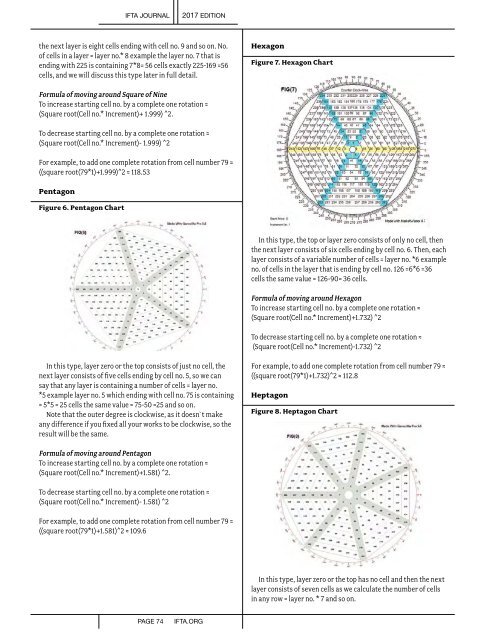You also want an ePaper? Increase the reach of your titles
YUMPU automatically turns print PDFs into web optimized ePapers that Google loves.
IFTA JOURNAL<br />
2017 EDITION<br />
the next layer is eight cells ending with cell no. 9 and so on.No.<br />
of cells in a layer = layer no.* 8example the layer no. 7 that is<br />
ending with 225 is containing 7*8= 56 cells exactly 225-169 =56<br />
cells, and we will discuss this type later in full detail.<br />
Hexagon<br />
Figure 7. Hexagon Chart<br />
Formula of moving around Square of Nine<br />
To increase starting cell no. by a complete one rotation ≈<br />
(Square root(Cell no.* Increment)+ 1.999) ^2.<br />
To decrease starting cell no. by a complete one rotation ≈<br />
(Square root(Cell no.* Increment)- 1.999) ^2<br />
For example, to add one complete rotation from cell number 79 ≈<br />
((square root(79*1)+1.999)^2 ≈ 118.53<br />
Pentagon<br />
Figure 6. Pentagon Chart<br />
In this type, the top or layer zero consists of only no cell, then<br />
the next layer consists of six cells ending by cell no. 6. Then, each<br />
layer consists ofa variable number of cells = layer no. *6example<br />
no. of cells in the layer that is ending by cell no. 126 =6*6 =36<br />
cells the same value = 126-90= 36 cells.<br />
Formula of moving around Hexagon<br />
To increase starting cell no. by a complete one rotation ≈<br />
(Square root(Cell no.* Increment)+1.732) ^2<br />
To decrease starting cell no. by a complete one rotation ≈<br />
(Square root(Cell no.* Increment)-1.732) ^2<br />
In this type, layer zero or the top consists of just no cell, the<br />
next layer consists of five cells ending by cell no. 5, so we can<br />
say that any layer is containing a number of cells = layer no.<br />
*5example layer no. 5 which ending with cell no. 75 is containing<br />
= 5*5 = 25 cells the same value = 75-50 =25 and so on.<br />
Note that the outer degree is clockwise, as it doesn`t make<br />
any difference if you fixed all your works to be clockwise, so the<br />
result will be the same.<br />
For example, to add one complete rotation from cell number 79 ≈<br />
((square root(79*1)+1.732)^2 ≈ 112.8<br />
Heptagon<br />
Figure 8. Heptagon Chart<br />
Formula of moving around Pentagon<br />
To increase starting cell no. by a complete one rotation ≈<br />
(Square root(Cell no.* Increment)+1.581) ^2.<br />
To decrease starting cell no. by a complete one rotation ≈<br />
(Square root(Cell no.* Increment)- 1.581) ^2<br />
For example, to add one complete rotation from cell number 79 ≈<br />
((square root(79*1)+1.581)^2 ≈ 109.6<br />
In this type, layer zero or the top has no cell and then the next<br />
layer consists of seven cells as we calculate the number of cells<br />
in any row = layer no. * 7 and so on.<br />
PAGE 74<br />
IFTA.ORG


